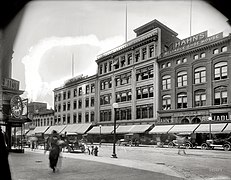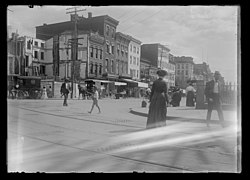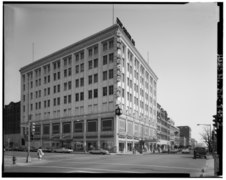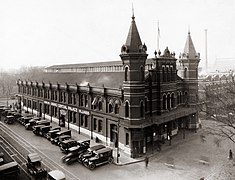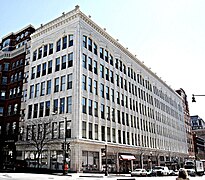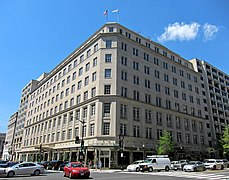
Tysons Corner Center is a shopping mall in the unincorporated area of Tysons in Fairfax County, Virginia, United States. It opened to the public in 1968, becoming one of the first fully enclosed, climate-controlled shopping malls in the Washington metropolitan area. The mall's features the traditional retailers Macy's, Nordstrom, and Bloomingdale's. The mall also features prominent specialty retailers including Everlane, Fabletics, Untuckit, Oak + Fort, Intimissimi, Aesop, and Warby Parker.

Friendship Heights is an urban commercial and residential neighborhood in northwest Washington, D.C., and southern Montgomery County, Maryland. Though its borders are not clearly defined, Friendship Heights consists roughly of the neighborhoods and commercial areas around Wisconsin Avenue north of Fessenden Street NW and Tenleytown to Somerset Terrace and Willard Avenue in Maryland, and from River Road in the west to Reno Road and 41st Street in the east. Within Maryland west of Wisconsin Avenue is the Village of Friendship Heights, technically a special taxation district.
Hecht's, also known as Hecht Brothers, Hecht Bros. and The Hecht Company, was a large chain of department stores that operated mainly in the mid-Atlantic and southern region of the United States. The firm originated in Baltimore, Maryland.
Strawbridge's, formerly Strawbridge & Clothier, was a department store in the northeastern United States, with stores in Pennsylvania, New Jersey, and Delaware. The Center City Philadelphia flagship store was, in its day, a gracious urban emporium. The retailer started adding branch stores starting in the 1930s and, by their zenith in the 1980s, enjoyed annual sales of over a billion dollars By the 1990s, Strawbridge's became part of the May Department Stores conglomerate until May's acquisition by Federated Department Stores on August 30, 2005.

Mount Vernon Square is a city square and neighborhood in the Northwest quadrant of Washington, D.C. The square is located where the following streets would otherwise intersect: Massachusetts Avenue NW, New York Avenue NW, K Street NW, and 8th Street NW.
Woodward & Lothrop was a department store chain headquartered in Washington, D.C. that began as the capital's first department store in 1887. Woodies, as it was often nicknamed, maintained stores in the Mid-Atlantic United States. Its flagship store was a fixture of Washington, D.C.'s downtown shopping district, competing with Garfinckel's and acquiring Palais Royal. The chain filed for bankruptcy in January 1994 and completed liquidation in November 1995, with most locations sold to either J. C. Penney or May Department Stores Company. The flagship building is a D.C. historic landmark that became the center of controversy over competing visions for DC's urban renewal after the chain's demise, and the former service warehouse in the city's northeast is also listed as a landmark.
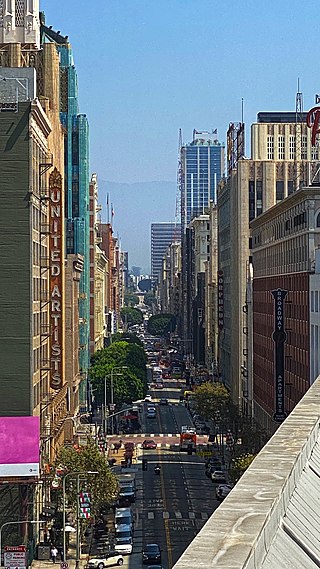
Broadway, until 1890 Fort Street, is a thoroughfare in Los Angeles County, California, United States. The portion of Broadway from 3rd to 9th streets, in the Historic Core of Downtown Los Angeles, was the city's main commercial street from the 1910s until World War II, and is the location of the Broadway Theater and Commercial District, the first and largest historic theater district listed on the National Register of Historic Places (NRHP). With twelve movie palaces located along a six-block stretch of Broadway, it is the only large concentration of movie palaces left in the United States.

Penn Quarter, often referred to as Old Downtown, is a historic neighborhood of Downtown Washington, D.C., located north of Pennsylvania Avenue, in Northwest D.C. Penn Quarter is roughly equivalent to the city's early downtown core near Pennsylvania Avenue and 7th Street NW, Penn Quarter is an entertainment and commercial hub, home to many museums, theaters, cinemas, restaurants, bars, art galleries and retail shops. Landmarks include the Capital One Arena, the National Portrait Gallery, and the Harman Center for the Arts, among others. The area is also home to a popular farmers market and several food, wine, art, and culture focused festivals.
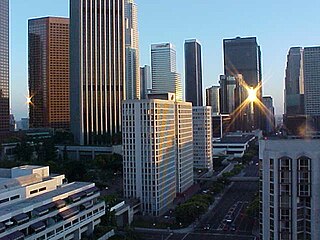
The Financial District is the central business district of Los Angeles along Olive, Grand, Hope, Flower and Figueroa streets from 4th Street to 8th Street. It is south of the Bunker Hill district, west of the Historic Core, north of South Park and east of the Harbor Freeway and Central City West. Like Bunker Hill, the Financial District is home to corporate office skyscrapers, hotels and related services as well as banks, law firms, and real estate companies. However, unlike Bunker Hill which was razed and now consists of buildings constructed since the 1960s, it contains large buildings from the early 20th century, particularly along Seventh Street, once the city's upscale shopping street; the area also attracts visitors as the 7th and Flower area is at the center of the regional Metro rail system and is replete with restaurants, bars, and shopping at two urban malls.

Garfinckel's was a prominent department store chain based in Washington, D.C. that catered to a clientele of wealthy consumers. Its flagship store at 14th and F in the city's F Street shopping district is listed on the National Register. It filed for Chapter 11 bankruptcy in June 1990 and ceased operations that year.
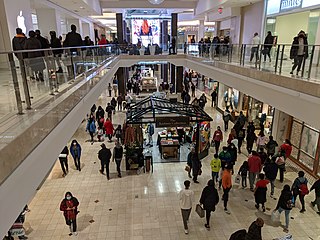
Westfield Montgomery is a shopping mall in Bethesda, Maryland. Major tenants include Macy's, Macy's Home, and Nordstrom, as well as specialty brands like Fabletics, Madewell, Vineyard Vines, and Untuckit.

Westfield Wheaton, formerly known as Wheaton Plaza, is a 1.7 million square-foot, two-level indoor shopping mall in Wheaton, Maryland, north of Washington, D.C. It is owned by Unibail-Rodamco-Westfield and Its anchor stores include Macy’s, Target, JCPenney, Dick's Sporting Goods, and Costco.
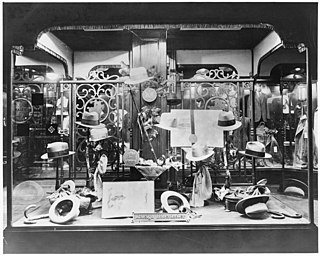
Raleigh Haberdasher, more commonly called Raleigh's, was a high end, local men's and women's furnishings store based in Washington, D.C.
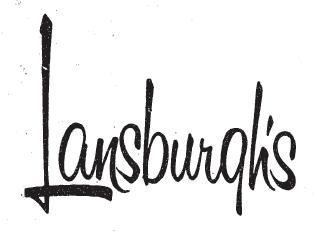
Lansburgh's was a chain of department stores located in the Washington, D.C. area. The clientele were middle-income consumers.

S. Kann Sons Co., or more commonly Kann's was a department store based in Washington, D.C. It was the city's second department store and pioneered the one-price policy and "the customer is always right" concept in retailing on the Washington, D.C. retail scene. The stores allowed consumers to return goods for cash.

The Shops at National Place was a three-level, indoor shopping mall located in downtown Washington, D.C. in the 16-story National Place Building. It is located on the block bounded by Pennsylvania Avenue, F Street, between 13th and 14th Streets NW, the former site of the Munsey Trust Building. It was located near the Metro Center station of the Washington Metro system.
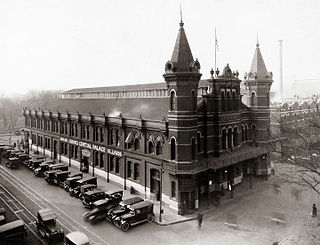
Center Market was a market hall in Washington, D.C. designed by architect Adolph Cluss which operated in Washington, DC from 1872 to 1931. The building was demolished in 1931 to be replaced by the National Archives Building. A market called Center Market had been in operation on the same block of land since 1802. In 1931, the name of Center Market was transferred over to the Northern Liberty Market located a few blocks north.

7th Street is a street in Los Angeles, California running from S. Norton Ave in Mid-Wilshire through Downtown Los Angeles. It goes all the way to the eastern city limits at Indiana Ave., and the border between Boyle Heights, Los Angeles and East Los Angeles.

Palais Royal was a large department store in Washington, D.C. at 11th and G streets NW in the F Street shopping district. It also grew into a small chain before being purchased and merged into the Woodward & Lothrop chain.




